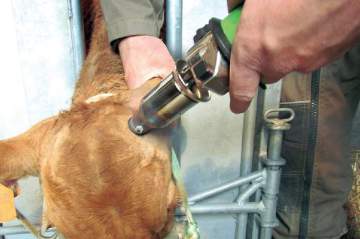
Both bovine and caprine dehorning makes it possible to protect animals in feed fences. Thanks to improved techniques, it can now be done on very young animals. This practice represents both a measure of well-being and safety for animals living in groups, as well as that of their breeder.
Why dehorn cattle and goats?
When the animals are on pasture, each has their own space and they are not confined to a smaller area. On the other hand, as soon as the animals are confined in the case of feeding in racks for open-air herds, for example, or are locked up in stables, problems are naturally created.
When they are confined, competition for access to feed, water and sleeping space can create conflict. This phenomenon is all the more pronounced when the natural hierarchy takes over and generates inter-animal intimidation that can turn into dangerous fights for the animals themselves..
Any conflict can result in varying degrees of injury, sometimes even physical suffering and permanent stress for the animals.
Once dehorning of cattle or goats is completed, the animals pose less of a danger to themselves, each otherand to the farmer. Of course, it is also physically much easier for them to enter a feed fence, whereas with their horns, the animal can sometimes have difficulty feeding and drinking and sometimes even get stuck because of their horns.
Finally, dehorning naturally pacifies the animals, especially the males who become less aggressive.
When to dehorn
Bovine and caprine dehorning
The dehorning of a calf or goat requires several interventions that are spread over the calving season, as it can and should be done as early as the third week after birth. It allows the animal’s health to be monitored at the same time and is seen as another positive aspect dehorning practice for the farmer.
Dehorning methods are now greatly facilitated with the appearance of dehorning restraint cages that are much better designed for the breeder and much more comfortable for the animal. The restraint cage keeps the animal in place so that it cannot move it’s head back without making itself uncomfortable and feeling overly confined..
The earlier dehorning is completed, the easier it is to restrain the animal. A younger animal has essentially less power and is also less stressed than an adultanimal would be. Moreover, a younger animal will not experience life with horns and are therefore much less likely to miss them when they are gone..
It is not necessary for the horn to have fully grown to be able to dehorn a calf or goat. The horns develop from the venous supply at their base. By cauterizing this source, the horn won’t be able to grow.
Adult cattle and goat dehorning
It is possible to dehorn adult animals, but the method is not the same and is much more painful for the animal. In this case the horns will be cut with a hydraulic debarker or chainsaw system. This operation is much more stressful for the animal, because it is more violent, noisier and requires at least a local anaesthetic which is not always practiced by the breeder. Moreover, it is traumatic because the animal loses a part of itself that they have grown accustomed to.
Thermal dehorning versus chemical dehorning
There are at least two main methods of dehorning, chemical or thermal. They both require the use of a restraint cage and the shearing of the area to be treated. Chemical dehorning involves the use of a soda-based paste that will create a sore-like patch that will dry before falling off after two to three weeks.
Thermal dehorning uses a special nozzle that adapts to the size of the horn. It digs a furrow around the base which inactivates the peripheral matrix of the bud. This allows dehorning to take place very early, because the bud appears from the first days of the animal’s life.
In the case of so-called “thermal” dehorning, the dehorners can be electric or gas. They can operate on mains power, batteries and gas cartridges, for a ‘wireless’ handling.
Thermal dehorning is preferred for the animal’s well-being, because it is much less painful than the chemical process, not to mention “cutting” the horn.
When considering the welfare of the animal, you must think about the method of dehorning to use.





